Popular categories
Looking for a yarn?

50% Cotton, 50% Polyester
from 7.00 RON /50g
Order DROPS Cotton Light from Andrele
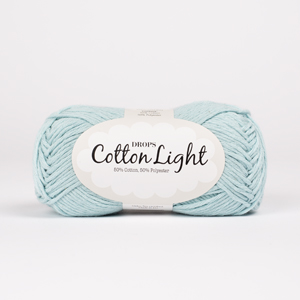
|
DROPS Cotton Light uni colour 50% Cotton, 50% Polyester |
7.00 RON /50g |
Order |
Clicking the ORDER button will redirect you to Andrele website
The yarn cost is calculated from the pattern’s smallest size and the yarn’s cheapest product type. Looking for an even better price? You might find it on the DROPS Deals!
Aphrodite
Crochet DROPS top with fans and star pattern in ”Cotton Light”. Size: S - XXXL.
DROPS design: Pattern no cl-038
Yarn group B
----------------------------------------------------------
Size: S - M - L - XL - XXL - XXXL
Materials:
DROPS COTTON LIGHT from Garnstudio
350-350-400-450-450-500 g colour no 01, off white
DROPS CROCHET HOOK SIZE 3.5 mm – or size needed to get 20 tr x 10 rows = 10 x 10 cm.
DROPS MOTHER-OF-PEARL BUTTON ARCHED (white), NO 521: 1 piece
-------------------------------------------------------
Alternative Yarn – See how to change yarns here
Yarn Groups A to F – Use the same pattern and change the yarn here
Yarn usage using an alternative yarn – Use our yarn converter here
-------------------------------------------------------

50% Cotton, 50% Polyester
from 7.00 RON /50g
Order DROPS Cotton Light from Andrele

|
DROPS Cotton Light uni colour 50% Cotton, 50% Polyester 7.00 RON /50g Order |
Clicking the ORDER button will redirect you to Andrele website
The yarn cost is calculated from the pattern’s smallest size and the yarn’s cheapest product type. Looking for an even better price? You might find it on the DROPS Deals!
- English (UK/cm), Romania
- Česky
- Dansk
- Deutsch
- Eesti keel
- English (UK/cm)
- English (US/in)
- Español
- Français
- Íslenska
- Italiano
- Magyar
- Nederlands
- Norsk
- Polski
- Português
- Suomi
- Svenska
- English (UK/cm), Bulgaria
- English (UK/cm), Croatia
- English (UK/cm), Greece
- English (UK/cm), Latvia
- English (UK/cm), Lithuania
- English (UK/cm), Slovenia
- Česky, Slovakia
Pattern instructions
See diagrams A.1 to A.5.
CROCHET INFO:
Replace first tr at beg of every tr row/round with 3 ch. Finish a round with tr with 1 sl st in 3rd ch.
Replace first dc at beg of every dc row/round with 1 ch. Finish a round with 1 sl st in ch from beg of round.
Replace first triple tr at beg on round with 5 ch. Finish a round with 1 sl st in 5th ch
DECREASE TIP:
Dec 1 tr by working 2 tr tog as follows: Work 1 tr but wait with last pull through (= 2 sts on hook), then work next tr but on last pull through, pull yarn through all 3 sts on hook.
----------------------------------------------------------
TOP:
Worked in several parts. First work front piece, then 2 triangles that are put tog for back piece, then work the body downwards.
FRONT PIECE:
Work 175-194-213-237-266-295 ch on hook size 3.5 mm with Cotton Light. Turn and work 1 tr in fourth ch from hook (= 2 tr), * skip 1 ch, 1 tr in each of the next 5 ch *, repeat from *-* and finish by skipping 1 ch, 1 tr in each of the last 2-3-4-4-3-2 ch = 144-160-176-196-220-244 tr. Turn piece. Front piece is now worked back and forth over the first 72-80-88-98-110-122 tr on row. READ CROCHET INFO! Work 1 tr in every tr AT THE SAME TIME dec 1 tr in each side on every row - READ DECREASE TIP. Dec 16-18-19-21-22-24 times in total in each side = 40-44-50-56-66-74 tr, piece now measures approx. 17-19-20-22-23-25 cm. Now work only over the first 10-11-13-15-19-22 tr on row (= from RS) as follows: Work 1 tr in every tr while AT THE SAME TIME dec 1 tr in each side of piece = 8-9-11-13-17-20 tr. Work 1 row more the same way = 6-7-9-11-15-18 tr. Then work 1 tr in every tr, the dec towards mid front is now done, but continue to dec 1 st in the side (towards armhole) on every row 2-3-5-7-11-14 more times = 4 tr remain on strap in all sizes. Continue with 1 tr in every tr until piece measures 40-44-48-52-56-60 cm from ch-row. Fasten off. Repeat in the opposite side but now work over the last 10-11-13-15-19-22 tr on row. The 20-22-24-26-28-30 tr in the middle of piece not worked = neck.
BACK PIECE:
Back piece consists of two triangles that are sewn tog.
TRIANGLE 1 (top part of back): Work 33 ch on hook size 3.5 mm with Cotton Light. Turn and work 1 dc in second ch from hook (= 2 dc), work 1 dc in each of the next 3 ch, * skip 1 ch, 1 dc in each of the next 5 ch *, repeat from *-* and finish by skipping 1 ch, 1 dc in each of the last 3 ch = 28 dc. Turn and work according to A.1. Cut the yarn when triangle is done and put it aside.
TRIANGLE 2: This is worked in the same tr-row as front piece. Skip 22-26-30-35-41-47 tr (= armhole) after last tr on front piece. Work 1 dc in each of the next 28 tr, turn and work back and forth according to A.1 (22-26-30-35-41-47 tr remain on row after A.1 = armhole). When this triangle is done, sew them tog in the tip.
BODY:
Worked top down, on underside of ch-row from front and back piece. First work back and forth, then work in the round.
From RS: Beg in first ch, work 3 ch (= 1 tr), then work 1 tr in bottom edge of every tr from tr-row = 144-160-176-196-220-244 tr.
ROW 1 (WS):
Work 1 dc in every tr, AT THE SAME TIME adjust no of sts to 144-168-180-192-216-240 dc.
ROW 2 (RS): Work A.2 A (= 6 sts), work A.2 B over the next 132-156-168-180-204-228 sts, work A.2 C (= 6 sts). Work A.2 back and forth one time vertically. On last row in A.2 work 1 sl st at beg of round, now work piece in the round.
ROUND 1: Work sl st until 1st ch-loop and now work after A.3 A: Work as follows in every ch-space: 1 tr + 2 ch + 1 tr + 2 ch. In every tr-group work as follows: 1 tr in second tr, 2 ch, 1 tr in 4th tr, 2 ch, 1 tr in 6th tr, 2 ch, BUT 4-2-5-8-6-12 times evenly on round work according to A.3 B: Work as follows in every ch-space: 1 tr + 2 ch + 1 tr + 2 ch. In every tr-group work as follows: 1 tr in 2nd tr, 2 ch, 1 tr in 3rd tr, 2 ch, 1 tr in 5th tr, 2 ch, 1 tr in 6th tr, 2 ch (work 4 tr in fan instead of 3) = 64-72-80-88-96-112 tr with 2 sts between every tr. Finish round with 1 sl st in 3rd ch from beg of round.
Then work according to A.4 (8-9-10-11-12-14 repetitions in width).
Work A.4 1 time vertically, there are now 72-81-90-99-108-126 tr with 2 ch between every tr on round. Work a round with 1 tr + 2 ch in every tr, AT THE SAME TIME inc 0-3-0-3-0-0 tr evenly, inc by working 1 tr + 2 ch + 1 tr + 2 ch in a tr = 72-84-90-102-108-126 tr. Then work according to diagram A.5 (12-14-15-17-18-21 repetitions in width). Work diagram A.5 one time vertically. Fasten off. Piece now measures approx. 31 cm in all sizes from ch-row in waist and 63-65-67-69-71-73 cm in total.
ASSEMBLY:
Sew shoulder straps in each side on the top triangle on back piece (sew the 4 tr from shoulder strap against the 4 outermost dc in each side on triangle – NOTE! Try the top first and adjust length of straps if needed).
CROCHET EDGE:
Work an edge around the neck as follows:
ROUND 1: Work 1 ch, 1 dc, * 1 ch, skip approx. 1 cm, 1 dc *, repeat from *-* and finish with 1 sl st in ch at beg of round – make sure to work a no of dc/ch that is divisible by 4.
ROUND 2: Work 1 ch, * 1 dc in first dc, 3 ch, 1 sl st in same dc, work 1 dc in next ch, 1 dc in next dc, 1 dc in next ch *, repeat *-* and finish with 1 sl st in first ch on round. Fasten off.
Work as follows around the armholes (make sure not to work the edge too loose):
ARMHOLE WITHOUT VENT:
ROUND 1: Work 1 ch, 1 dc, * 1 ch, skip approx. 1 cm, 1 dc *, repeat from *-* and finish with 1 sl st in ch at beg of round – make sure to work a no of dc/ch that is divisible by 4.
ROUND 2: 3 ch ( = 1 tr), 1 tr in next dc, * 2 ch, skip 1 ch and 1 dc, 1 tr in next ch, 1 tr in next dc *, repeat from *-*, finish with 2 ch and 1 sl st in 3rd ch from beg of round.
ROUND 3: 1 ch, work 1 dc in every tr and 2 dc in every ch-space, finish with 1 sl st in first ch.
ROUND 4: Work 1 ch, * 1 dc in first dc, 3 ch, 1 sl st in same dc, work 1 dc in each of the next 3 dc *, repeat from *-* and finish with 1 sl st in first ch on round. Fasten off.
ARMHOLE WITH VENT:
ROW 1 (= from WS): Work 1 ch, 1 dc, * 1 ch, skip approx. 1 cm, 1 dc *, repeat from *-* – make sure to work a no of dc/ch that is divisible by 4 + 2. Turn.
ROW 2: 3 ch ( = 1 tr), 1 tr in next dc, * 2 ch, skip 1 ch and 1 dc, 1 tr in next ch, 1 tr in next dc *, repeat from *-*. Turn.
ROW 3: 1 ch, work 1 dc in every tr and 2 dc in every ch-space. Turn.
ROW 4: Work 1 ch, * 1 dc in next dc, 3 ch, 1 sl st in same dc, work 1 dc in each of the next 3 dc *, repeat from *-* 1 dc in next dc, 3 ch, 1 sl st in same dc, 1 dc in next dc. Fasten off.
Sew a button at the top of vent, button through first tr in opposite side.
TIES:
Cut 2 lengths of 3 metres each. Twine the strands tog until they resist, fold the string double so that it twines again. Make a knot at each end. Thread tie up and down in row with tr in waist.
This pattern has been corrected. Click here to see the correction/s.
Correction in the 9th chart text.
= quintuple treble in st
The icons in the 1st row in A.1 is change into:
= dc in st below (not dc around st below)
under BODY and ROUND 1:
ROUND 1: Work sl st until 1st ch-loop and now work after A.3 A:...
Extra text under CROCHET INFO:
Replace first triple tr at beg on round with 5 ch. Finish round with 1 sl st in 5th ch.
+
New chart A.5 (many tr in st is replaced with tr around st).
Correction - BODY ROUND 1: BUT 4-2-5-8-6-12 times evenly on round work according to A.3B
Diagram

|
= ch |

|
= ch |

|
= dc in st below |

|
= dc around st below |

|
= tr in st |

|
= tr around st |

|
= dtr in st |

|
= triple tr in st |

|
= quintuple treble in st |

|
= 8 ch |

|
= Work 1 tr in next tr - but wait with last pull through (= 2 sts on hook), work 1 tr in each of the next 2 tr the same way, pull yarn through all 4 sts on hook |

|
= Work 2 tr tog as follows: Work 1 tr – but wait with last pull through (= 2 sts on hook), work 1 tr in the same st, pull yarn through all 3 sts on hook. |

|
= Shows last round from previous diagram |

|
= Crochet direction |

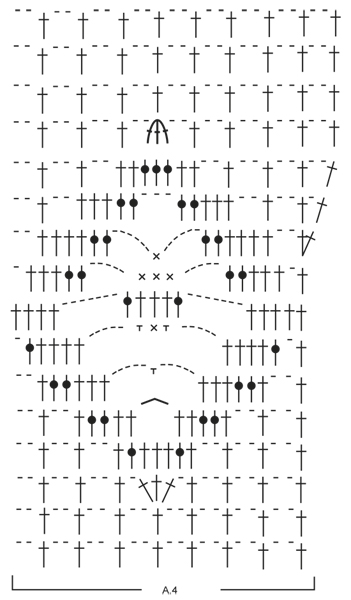
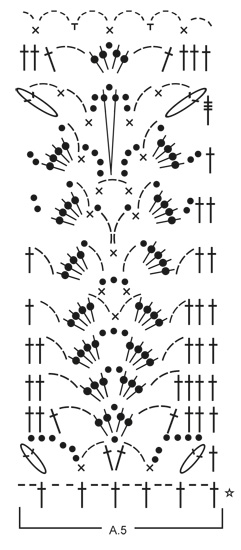
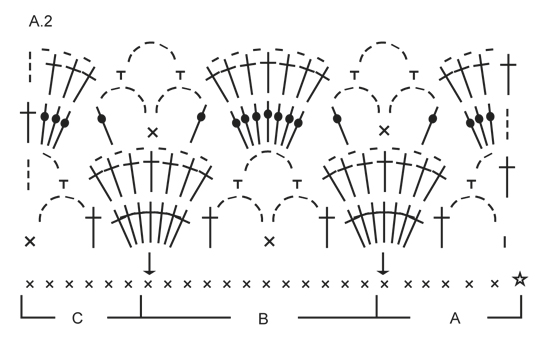
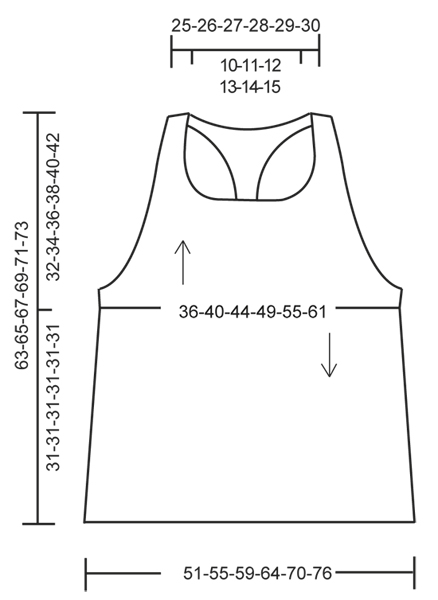
What can you do with our patterns? You can share DROPS patterns online, using the pattern original picture, materials, name and number. But you are NOT ALLOWED to reproduce the complete pattern digitally in any way. Yarn stores are welcome to use the DROPS pattern database to promote the sale of our assortment. You can print out our patterns, make as many copies as you’d like. The only thing we ask is that you don't make any changes / additions to the original printed document. And that the patterns according to the DROPS philosophy are given out to the consumers for free. Editorials that wish to publish our patterns in printed books or magazines can contact us for more information. The sale of garments based on DROPS patterns is permitted as long as they are sold as single items or per order. Further commercial use of the patterns is not permitted. It has to be clearly stated that the garment is made based on a design from DROPS DESIGN. The use of clothing labels of which DROPS DESIGN forms part is conditioned by the inclusion of the following text: “A DROPS DESIGN made by …..”. The use of DROPS photos for marketing purposes/sales is only permitted in connection with the use/sale of DROPS products. The photos may not be cut or edited and the logo should be clearly visible.
We reserve the right to withdraw the permission for use of our patterns at any time, notwithstanding the reason.
Each of our patterns has specific tutorial videos to help you.
These step-by-step tutorials might also help you:
Why is the knitting/crochet tension so important?
Knitting tension is what determines the final measurements of your work, and is usually measured per 10 x 10 cm. It is provided like so: number of stitches in width x number of rows in height - eg: 19 stitches x 26 rows = 10 x 10 cm.
The knitting tension is very individual; some people knit/crochet loosely while others work tightly. You adjust the knitting tension with the needle size, which is why the suggested needle size is only meant as a guide! You need to adjust this (up or down) to ensure that YOUR knitting tension matches the knitting tension provided in the pattern. If you work with a different knitting tension than provided you will have a different yarn consumption, and your work will have different measurements than what the pattern suggests.
The knitting tension also determines which yarns can replace each other. As long as you achieve the same knitting tension you can replace one yarn with another.
See DROPS lesson: How to measure your tension/gauge
See DROPS video: How to make a gauge tension swatch
How do I know how many balls of yarn I need?
The required amount of yarn is provided in grams, eg: 450 g. To calculate how many balls you’ll need you first need to know how many grams are in 1 ball (25g, 50g or 100g). This information is available if you click on the individual yarn quality on our pages. Divide the amount required with the amount of each ball. For example, if each ball is 50g (the most common amount), the calculation will be as follows: 450 / 50 = 9 balls.
Can I use a different yarn than what the pattern suggests?
The important thing when changing from one yarn to another is that the knitting/crochet tension remains the same. This is so that the measurements of the finished piece will be the same as on the sketch provided. It is easier to achieve the same knitting tension using yarns from the same yarn group. It is also possible to work with multiple strands of a thinner yarn to achieve the knitting tension of a thicker one. Please try our yarn converter. We recommend you to always work a test swatch.
Please NOTE: when changing yarn the garment might have a different look and feel to the garment in the photo, due to individual properties and qualities of each yarn.
See DROPS lesson: Can I use a different yarn than the one mentioned in the pattern?
What are the yarn groups?
All our yarns are categorised into yarn groups (from A to F) according to thickness and knitting tension – group A contains the thinnest yarns and group F the thickest. This makes it easier for you to find alternative yarns to our patterns, should you wish to switch yarn. All yarns within the same group have a similar knitting tension and can easily replace each other. However, different yarn qualities have different structures and properties which will give the finished work a unique look and feel.
How do I use the yarn calculator?
At the top of all our patterns you’ll find a link to our yarn calculator, which is a helpful tool should you wish to use a different yarn than suggested. By filling in the yarn quality you wish to replace, the amount (in your size) and number of strands, the calculator will present good alternative yarns with the same knitting tension. Additionally it will tell you how much you’ll require in the new qualities and whether you’ll need to work with multiple strands. Most skeins are 50g (some are 25g or 100g).
If the pattern is worked with multiple colours, every colour will have to be calculated separately. Similarly, if the pattern is worked with several strands of different yarns (for example 1 strand Alpaca and 1 strand Kid-Silk) you will have to find alternatives for each, individually.
Why do you show discontinued yarns in the patterns?
Since different yarns have different qualities and textures we have chosen to keep the original yarn in our patterns. However, you can easily find options among our available qualities by using our yarn calculator, or simply pick a yarn from the same yarn group.
It is possible that some retailers still have discontinued yarns in stock, or that someone has a few skeins at home that they would like to find patterns for.
The yarn calculator will provide both alternative yarn as well as required amount in the new quality.
What size should I knit?
If you think it's hard to decide what size to make, it can be a good idea to measure a garment you own already and like the size of. Then you can pick the size by comparing those measures with the ones available in the pattern's size chart.
You'll find the size chart at the bottom of the pattern.
See DROPS lesson: How to read size chart
Why do I get the wrong knitting tension with the suggested needle size?
The needle size provided in the pattern serves only as a guide, the important thing is to follow the knitting tension. And since knitting tension is very individual, you will have to adjust the needle size to ensure that YOUR tension is the same as in the pattern – maybe you’ll have to adjust 1, or even 2 needle sizes, up or down to achieve the correct tension. For this, we recommend that you work test swatches.
Should you work with a different knitting tension than the one provided, the measurements of the finished garment might deviate from the measurement sketch.
See DROPS lesson: How to measure your tension/gauge
See DROPS video: How to make a tension/gauge swatch
Why is the pattern worked top-down?
Working a garment top-down provides more flexibility and room for personal adjustment. For example it is easier to try the garment on while working, as well as making adjustments to length of yoke and shoulder caps.
The instructions are carefully explaining every step, in the correct order. Diagrams are adjusted to the knitting direction and are worked as usual.
How do I work according to a knitting diagram?
The diagram depicts all rows/rounds, and every stitch seen from the right side. It is read from bottom to top, from right to left. 1 square = 1 stitch.
When working back and forth, every other row is worked from the right side and every other row is worked from the wrong side. When working from the wrong side, the diagram will have to be worked reversed: from left to right, knit stitches are purled, purl stitches are knit etc.
When working in the round every round is worked from the right side and the diagram are worked from right to left on all rounds.
See DROPS lesson: How to read knitting diagrams
How do I work according to a crochet diagram?
The diagram depicts all rows/rounds, and every stitch seen from the right side. It is worked from bottom to top, from right to left.
When working back and forth every other row is worked from the right side: from right to left and every other row is worked from the wrong side: from left to right.
When working in the round, every row in the diagram are worked from the right side, from right to left.
When working a circular diagram you start in the middle and work your way outwards, counter clockwise, row by row.
The rows usually start with a given number of chain stitches (equivalent to the height of the following stitch), this will either be depicted in the diagram or explained in the pattern.
See DROPS lesson: How to read crochet diagrams
How do I work several diagrams simultaneously on the same row/round?
Instructions for working several diagrams after each other on the same row/round, will often be written like so: “work A.1, A.2, A.3 a total of 0-0-2-3-4 times". This means you work A.1 once, then A.2 is worked once, and A.3 is repeated (in width) the number of times provided for your size – in this case like so: S = 0 times, M = 0 times, L=2 times, XL= 3 times and XXL = 4 times.
The diagrams are worked as usual: begin with the first row in A.1, then work the first row in A.2 etc.
See DROPS lesson: How to read knitting diagrams
See DROPS lesson: How to read crochet diagrams
Why are the sleeves shorter in larger sizes?
The total width of the garment (from wrist-to-wrist) will be larger in the larger sizes, despite the actual sleeves being shorter. The larger sizes have longer sleeve caps and wider shoulders, so there will be a good fit in all sizes.
Where on the garment is the length measured?
The measurement sketch/schematic drawing provides information regarding the full length of the garment. If it’s a jumper or a jacket the length is measured from the highest point on the shoulder closest to the neckline, and straight down to the bottom of the garment. It is NOT measured from the tip of shoulder. Similarly, the length of yoke is measured from the highest point on the shoulder and down to where yoke is split into body and sleeves.
On a jacket measures are never taken along bands, unless specifically stated. Always measure inside band stitches when measuring the length.
See DROPS lesson: How to read a schematic drawing
What is a repeat?
Diagrams are often repeated on the round or in height. 1 repeat is the diagram the way it appears in the pattern. If it says to work 5 repeats of A.1 in the round, then you work A.1 a total of 5 times after/next to each other in the round. If it says to work 2 repeats of A.1 vertically/in height you work the entire diagram once, then begin again at the start and work the entire diagram one more time.
Why does the piece start with more chain stitches than it’s worked with?
Chain stitches are slightly narrower than other stitches and to avoid working the cast-on edge too tight, we simply chain more stitches to begin with. The stitch count will be adjusted on the following row to fit the pattern and measurement sketch.
Why increase before the rib edge when the piece is worked top-down?
The rib edge is more elastic and will contract slightly compared to, for example, stocking stitch. By increasing before the rib edge, you avoid a visible difference in width between the rib edge and the rest of the body.
Why increase in the cast-off edge?
It’s very easy to cast off too tightly, and by making yarn overs while casting off (and simultaneously casting these off) you avoid a too tight cast off edge.
See DROPS video: How to bind off with yarn overs (yo)
How do I increase/decrease on every 3rd and 4th row/round alternately?
To achieve an even increase (or decrease) you can increase on, for example: every 3rd and 4th row alternately, like so: work 2 rows and increase on the 3rd row, work 3 rows and increase on the 4th. Repeat this until the increase is complete.
See DROPS lesson: Increase or decrease 1 st on every 3rd and 4th row alternately
How can I work a jacket in the round instead of back and forth?
Should you prefer to work in the round instead of back and forth, you may of course adjust the pattern. You’ll need to add steeks mid-front (usually 5 stitches), and follow the instructions. When you would normally turn and work from the wrong side, simply work across the steek and continue in the round. At the end you’ll cut the piece open, pick up stitches to work bands, and cover the cut edges.
See DROPS video: How to knit steeks and cut open
Can I work a jumper back and forth instead of in the round?
Should you prefer to work back and forth instead of in the round, you may of course adjust the pattern so you work the pieces separately and then assemble them at the end. Divide the stitches for the body in 2, add 1 edge stitch in each side (for sewing) and work the front and back pieces separately.
See DROPS lesson: Can I adapt a pattern for circular needles into straight needles?
Why is the pattern slightly different than what I see in the photo?
Pattern repeats can vary slightly in the different sizes, in order to get the correct proportions. If you’re not working the exact same size as the garment in the photo, yours might deviate slightly. This has been carefully developed and adjusted so that the complete impression of the garment is the same in all sizes.
Make sure to follow instructions and diagrams for your size!
How do I make a women’s size garment into a men’s size one?
If you have found a pattern you like which is available in women’s size it’s not very difficult to convert it to men’s size. The biggest difference will be the length of sleeves and body. Start working on the women size that you think would fit across the chest. The additional length will be worked right before you cast off for the armhole/sleeve cap. If the pattern is worked top-down you can add the length right after the armhole or before the first decrease on sleeve.
Regarding additional yarn amount, this will depend on how much length you add, but it is better with a skein too many than too few.
How do I prevent a hairy garment from shedding?
All yarns will have excess fibres (from production) that might come off as lint or shedding. Brushed yarns (ie hairier yarns) have more of these loose, excess fibres, causing more shedding.
Shedding also depends on what is worn under or over the garment, and whether this pulls at the yarn fibres. It’s therefore not possible to guarantee that there will be no shedding
Below are some tips on how to get the best result when working with hairier yarns:
1. When the garment is finished (before you wash it) shake it vigorously so the looser hairs come off. NOTE: do NOT use a lint roller, brush or any method that pulls at the yarn.
2. Place the garment in a plastic bag and put it in your freezer - the temperature will cause the fibres to become less attached to each other, and excess fibres will come off easier.
3. Leave in the freezer for a few hours before taking it out and shaking it again.
4. Wash the garment according to the instructions on the yarn label.
Why does my garment pill?
Pilling is a natural process that happens to even the most exclusive of fibers. It's a natural sign of wear and tear that is hard to avoid, and that is most visible in high friction areas of your garment like a sweater's arms and cuffs.
You can make your garment look as new by removing the pilling, using a fabric comb or a pill/lint remover.
In the meantime, you can read the questions and answers that others have left to this pattern or join the DROPS Workshop on Facebook to get help from fellow knitters/crocheters!
You might also like...
Aphrodite
162-1 Aphrodite
Aphrodite top
Coral Bamboo Aphrodite Racer Back Dress
162-1 Aphrodite
162-1 Aphrodite
Aphrodite summer top
Aphrodite top
Aphrodite
162-1 Aphrodite
Aphrodite top
Coral Bamboo Aphrodite Racer Back Dress
162-1 Aphrodite
162-1 Aphrodite
Aphrodite summer top
Aphrodite top
Aphrodite |
|||||||||||||||||||||||||||||||||||||||||||
 |
 |
||||||||||||||||||||||||||||||||||||||||||
Crochet DROPS top with fans and star pattern in ”Cotton Light”. Size: S - XXXL.
DROPS 162-1 |
|||||||||||||||||||||||||||||||||||||||||||
|
PATTERN: See diagrams A.1 to A.5. CROCHET INFO: Replace first tr at beg of every tr row/round with 3 ch. Finish a round with tr with 1 sl st in 3rd ch. Replace first dc at beg of every dc row/round with 1 ch. Finish a round with 1 sl st in ch from beg of round. Replace first triple tr at beg on round with 5 ch. Finish a round with 1 sl st in 5th ch DECREASE TIP: Dec 1 tr by working 2 tr tog as follows: Work 1 tr but wait with last pull through (= 2 sts on hook), then work next tr but on last pull through, pull yarn through all 3 sts on hook. ---------------------------------------------------------- TOP: Worked in several parts. First work front piece, then 2 triangles that are put tog for back piece, then work the body downwards. FRONT PIECE: Work 175-194-213-237-266-295 ch on hook size 3.5 mm with Cotton Light. Turn and work 1 tr in fourth ch from hook (= 2 tr), * skip 1 ch, 1 tr in each of the next 5 ch *, repeat from *-* and finish by skipping 1 ch, 1 tr in each of the last 2-3-4-4-3-2 ch = 144-160-176-196-220-244 tr. Turn piece. Front piece is now worked back and forth over the first 72-80-88-98-110-122 tr on row. READ CROCHET INFO! Work 1 tr in every tr AT THE SAME TIME dec 1 tr in each side on every row - READ DECREASE TIP. Dec 16-18-19-21-22-24 times in total in each side = 40-44-50-56-66-74 tr, piece now measures approx. 17-19-20-22-23-25 cm. Now work only over the first 10-11-13-15-19-22 tr on row (= from RS) as follows: Work 1 tr in every tr while AT THE SAME TIME dec 1 tr in each side of piece = 8-9-11-13-17-20 tr. Work 1 row more the same way = 6-7-9-11-15-18 tr. Then work 1 tr in every tr, the dec towards mid front is now done, but continue to dec 1 st in the side (towards armhole) on every row 2-3-5-7-11-14 more times = 4 tr remain on strap in all sizes. Continue with 1 tr in every tr until piece measures 40-44-48-52-56-60 cm from ch-row. Fasten off. Repeat in the opposite side but now work over the last 10-11-13-15-19-22 tr on row. The 20-22-24-26-28-30 tr in the middle of piece not worked = neck. BACK PIECE: Back piece consists of two triangles that are sewn tog. TRIANGLE 1 (top part of back): Work 33 ch on hook size 3.5 mm with Cotton Light. Turn and work 1 dc in second ch from hook (= 2 dc), work 1 dc in each of the next 3 ch, * skip 1 ch, 1 dc in each of the next 5 ch *, repeat from *-* and finish by skipping 1 ch, 1 dc in each of the last 3 ch = 28 dc. Turn and work according to A.1. Cut the yarn when triangle is done and put it aside. TRIANGLE 2: This is worked in the same tr-row as front piece. Skip 22-26-30-35-41-47 tr (= armhole) after last tr on front piece. Work 1 dc in each of the next 28 tr, turn and work back and forth according to A.1 (22-26-30-35-41-47 tr remain on row after A.1 = armhole). When this triangle is done, sew them tog in the tip. BODY: Worked top down, on underside of ch-row from front and back piece. First work back and forth, then work in the round. From RS: Beg in first ch, work 3 ch (= 1 tr), then work 1 tr in bottom edge of every tr from tr-row = 144-160-176-196-220-244 tr. ROW 1 (WS): Work 1 dc in every tr, AT THE SAME TIME adjust no of sts to 144-168-180-192-216-240 dc. ROW 2 (RS): Work A.2 A (= 6 sts), work A.2 B over the next 132-156-168-180-204-228 sts, work A.2 C (= 6 sts). Work A.2 back and forth one time vertically. On last row in A.2 work 1 sl st at beg of round, now work piece in the round. ROUND 1: Work sl st until 1st ch-loop and now work after A.3 A: Work as follows in every ch-space: 1 tr + 2 ch + 1 tr + 2 ch. In every tr-group work as follows: 1 tr in second tr, 2 ch, 1 tr in 4th tr, 2 ch, 1 tr in 6th tr, 2 ch, BUT 4-2-5-8-6-12 times evenly on round work according to A.3 B: Work as follows in every ch-space: 1 tr + 2 ch + 1 tr + 2 ch. In every tr-group work as follows: 1 tr in 2nd tr, 2 ch, 1 tr in 3rd tr, 2 ch, 1 tr in 5th tr, 2 ch, 1 tr in 6th tr, 2 ch (work 4 tr in fan instead of 3) = 64-72-80-88-96-112 tr with 2 sts between every tr. Finish round with 1 sl st in 3rd ch from beg of round. Then work according to A.4 (8-9-10-11-12-14 repetitions in width). Work A.4 1 time vertically, there are now 72-81-90-99-108-126 tr with 2 ch between every tr on round. Work a round with 1 tr + 2 ch in every tr, AT THE SAME TIME inc 0-3-0-3-0-0 tr evenly, inc by working 1 tr + 2 ch + 1 tr + 2 ch in a tr = 72-84-90-102-108-126 tr. Then work according to diagram A.5 (12-14-15-17-18-21 repetitions in width). Work diagram A.5 one time vertically. Fasten off. Piece now measures approx. 31 cm in all sizes from ch-row in waist and 63-65-67-69-71-73 cm in total. ASSEMBLY: Sew shoulder straps in each side on the top triangle on back piece (sew the 4 tr from shoulder strap against the 4 outermost dc in each side on triangle – NOTE! Try the top first and adjust length of straps if needed). CROCHET EDGE: Work an edge around the neck as follows: ROUND 1: Work 1 ch, 1 dc, * 1 ch, skip approx. 1 cm, 1 dc *, repeat from *-* and finish with 1 sl st in ch at beg of round – make sure to work a no of dc/ch that is divisible by 4. ROUND 2: Work 1 ch, * 1 dc in first dc, 3 ch, 1 sl st in same dc, work 1 dc in next ch, 1 dc in next dc, 1 dc in next ch *, repeat *-* and finish with 1 sl st in first ch on round. Fasten off. Work as follows around the armholes (make sure not to work the edge too loose): ARMHOLE WITHOUT VENT: ROUND 1: Work 1 ch, 1 dc, * 1 ch, skip approx. 1 cm, 1 dc *, repeat from *-* and finish with 1 sl st in ch at beg of round – make sure to work a no of dc/ch that is divisible by 4. ROUND 2: 3 ch ( = 1 tr), 1 tr in next dc, * 2 ch, skip 1 ch and 1 dc, 1 tr in next ch, 1 tr in next dc *, repeat from *-*, finish with 2 ch and 1 sl st in 3rd ch from beg of round. ROUND 3: 1 ch, work 1 dc in every tr and 2 dc in every ch-space, finish with 1 sl st in first ch. ROUND 4: Work 1 ch, * 1 dc in first dc, 3 ch, 1 sl st in same dc, work 1 dc in each of the next 3 dc *, repeat from *-* and finish with 1 sl st in first ch on round. Fasten off. ARMHOLE WITH VENT: ROW 1 (= from WS): Work 1 ch, 1 dc, * 1 ch, skip approx. 1 cm, 1 dc *, repeat from *-* – make sure to work a no of dc/ch that is divisible by 4 + 2. Turn. ROW 2: 3 ch ( = 1 tr), 1 tr in next dc, * 2 ch, skip 1 ch and 1 dc, 1 tr in next ch, 1 tr in next dc *, repeat from *-*. Turn. ROW 3: 1 ch, work 1 dc in every tr and 2 dc in every ch-space. Turn. ROW 4: Work 1 ch, * 1 dc in next dc, 3 ch, 1 sl st in same dc, work 1 dc in each of the next 3 dc *, repeat from *-* 1 dc in next dc, 3 ch, 1 sl st in same dc, 1 dc in next dc. Fasten off. Sew a button at the top of vent, button through first tr in opposite side. TIES: Cut 2 lengths of 3 metres each. Twine the strands tog until they resist, fold the string double so that it twines again. Make a knot at each end. Thread tie up and down in row with tr in waist. |
|||||||||||||||||||||||||||||||||||||||||||
Diagram explanations |
|||||||||||||||||||||||||||||||||||||||||||
|
|||||||||||||||||||||||||||||||||||||||||||

|
|||||||||||||||||||||||||||||||||||||||||||

|
|||||||||||||||||||||||||||||||||||||||||||

|
|||||||||||||||||||||||||||||||||||||||||||

|
|||||||||||||||||||||||||||||||||||||||||||

|
|||||||||||||||||||||||||||||||||||||||||||
|
Have you made this or any other of our designs? Tag your pictures in social media with #dropsdesign so we can see them! Do you need help with this pattern?You'll find tutorial videos, a Comments/Questions area and more by visiting the pattern on garnstudio.com. © 1982-2024 DROPS Design A/S. We reserve all rights. This document, including all its sub-sections, has copyrights. Read more about what you can do with our patterns at the bottom of each pattern on our site. |
|||||||||||||||||||||||||||||||||||||||||||
With over 40 years in knitting and crochet design, DROPS Design offers one of the most extensive collections of free patterns on the internet - translated to 17 languages. As of today we count 304 catalogues and 11422 patterns - 11422 of which are translated into English (UK/cm).
We work hard to bring you the best knitting and crochet have to offer, inspiration and advice as well as great quality yarns at incredible prices! Would you like to use our patterns for other than personal use? You can read what you are allowed to do in the Copyright text at the bottom of all our patterns. Happy crafting!








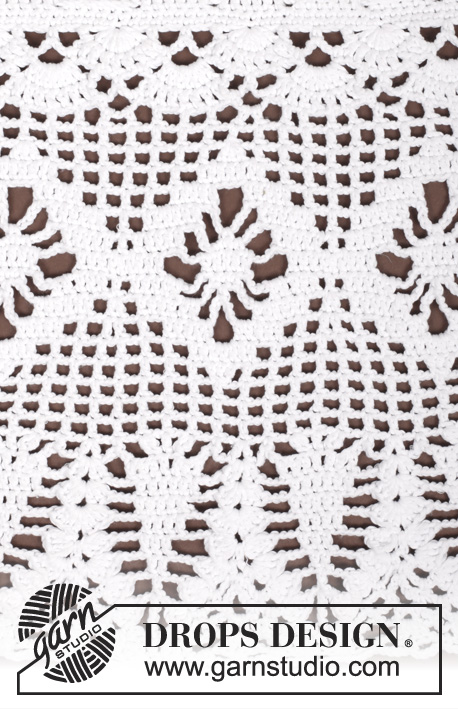





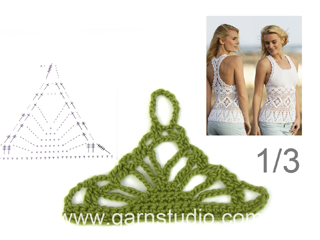
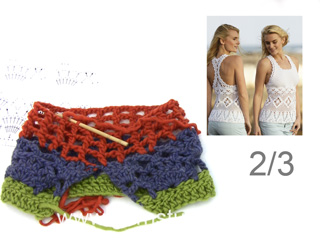
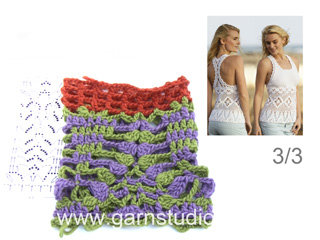












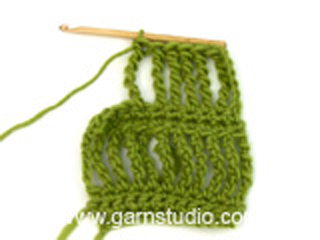























Comments / Questions (339)
I diagram A.5 omgang 9 (3. siste runde) så er det en lang hake/v i mønsteret jeg ikke får til å stemme hva er for noe. Håper dere kan hjelpe så jeg får gjort toppen ferdig.
03.04.2024 - 10:37DROPS Design answered:
Hei Liv. Det er en stav om maske (ikonet er gjort lengre slik at man bedre ser hvilken maske staven(e) skal hekles i). Se evnt hjelpe videoene til denne toppen. mvh DROPS Design
08.04.2024 - 11:58* skip ch 1, 1 dc in each of the next 5 ch *, repeat from *-* and finish by skipping ch 1, 1 dc in each of the last 2-3-4-4-3-2 ch = 144-160-176-196-220-244 dc. : Ik heb mijn opgezette lossen tig keer nageteld, ze kloppen. Ik heb de herhaling aangehouden, en bij het laatste stukje houd ik nog 5 lossen over. Maar ik begrijp niet hoe ik dan 1 losse moet overslaan, dan 1stokje in de laatste 3 moet haken. Dan houd ik uiteindelijk 1 losse over. Hopelijk kan iemand me helpen :(
28.05.2023 - 20:35DROPS Design answered:
Dag Wendy,
Helaas kan ik niet met je meekijken, maar als het verder allemaal klopt en je kunt hierop verder haken met de volgende toer, dan lijkt mij die ene steek niet zo'n punt. Deze kun je eventueel nog uithalen op het het eind.
29.05.2023 - 15:44Het geluid van de filmpjes staat aan, mijn pc werkt goed, maar ik hoor niets. Hoe kan dit?
17.05.2023 - 11:23Hvorfor er der to symboler for lm? både prik og og streg?
30.03.2023 - 00:11DROPS Design answered:
Hej Storm, de er brugt lidt forskelligt. Du har nogle videoer nederst i opskriften som viser forskellige moment i opskriften :)
13.04.2023 - 10:00Hallo wo ist denn das Diagramm für das Vorderteil, man weiß ja nicht wo genau man abnehmen muss. LG,Marion
22.03.2023 - 11:12DROPS Design answered:
Liebe Marion, die Abnahmen unter VORDERTEIL werden beidseitig gehäkelt, dafür gibt es kein Diagram, alles wird in der schriftlichen Anleitung erklärt. Viel Spaß beim häkeln!
22.03.2023 - 13:33Ik kom ook helemaal niet toe met de vooropgestelde 400m voor de maat L, wat suggereert dat de top toch strakker zou moeten zijn. Maar mijn maatvoering klopt/is zelfs iets strakker dan het patroon aangeeft?
12.03.2023 - 17:28DROPS Design answered:
Dag Kathleen,
Je hebt 400 gram nodig (niet 400 meter), dus 8 bollen.
14.03.2023 - 20:55Ik ben bijna helemaal klaar met het patroon in maat L. Mijn maatvoering klopt met het patroon: 20x10 = 10x10cm. Ik heb eigl zelfs eerder 19x10 stokjes. Toch valt de maat L veel groter uit dan het model op de foto laat zien. De top lijkt aan te passen maar valt in werkelijkheid super los. Heb ik me laten misleiden door de foto en is het een losse top?
12.03.2023 - 17:22DROPS Design answered:
Dag Kathleen,
Wat vervelend dat de maten niet kloppen. Als ik de maattekening bekijk zou het een redelijk aansluitende top moeten zijn. Heb je tijdens het haken ook de maatvoering in de gaten gehouden?
14.03.2023 - 20:58Zou het kunnen dat voor het voorpand de verhoudingen niet kloppen?\r\nEr moeten 213 lossen worden opgezet om nadien volgens patroon te haken en maar 176 stokjes over te houden??? Of er zijn teveel stokjes op dat moment, of er blijven nog een heleboel lossen over.\r\nBen al zeker 3 maal herbegonnen, ik begrijp er niets meer van.
04.03.2023 - 11:46DROPS Design answered:
Dag Ann,
Ja, dat klopt, want in de volgende toer sla je regelmatig een losse over. Dit wordt gedaan om te voorkomen dat de opzetrand niet te strak wordt.
08.03.2023 - 19:17Sto iniziando il davanti di questo progetto ma non capisco il procedimento dopo le 72 maglie alte. Nei suggerimenti lavoro parlano di un inizio/Giro con m a e poi di inizio/Giro con mb, devo intendere che si prosegue facendo una riga a m a e una riga a m b, procedendo con le diminuzioni solo nelle righe di m a? Grazie per la spiegazione
27.02.2023 - 13:56DROPS Design answered:
Buonasera Serena, il paragrafo del suggerimento spiega come iniziare il giro nelle diverse tipologie di inizio: se il giro che deve lavorare inizia a maglie alte, deve seguire le istruzioni per quel caso. Buon lavoro!
02.03.2023 - 19:10In terms of sizing, would the bust be the largest part of the chest or underneath the bust? My measuring around largest part is 46" which would bring me at a 3xl. I am usually an XL, so I am very confused by sizing. Thank you - Theresa
09.12.2022 - 04:16DROPS Design answered:
Hi Theresa, The chest measurements include the bust and we recommend that you use the size chart to decide which size to work. Happy crafting!
09.12.2022 - 06:47